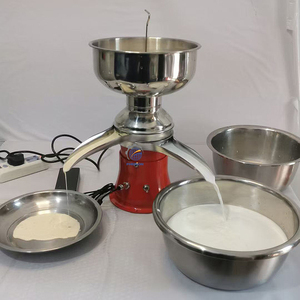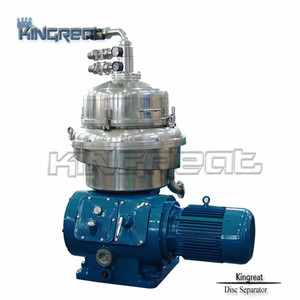(339 products available)











































































































































































































The milk degrease separator is a device designed to separate milk components based on density. It uses centrifugal force to separate the milk into different components, such as cream and skim milk. There are two main types of milk separators based on their working principles: gravity milk separators and centrifugal milk separators.
Based on operation methods, milk degrease separators can be continuous and batch milk separators. Automatic continuous separators have inlets and outlets for feeding and discharging separated materials. They are efficient and easier to operate. On the other hand, batch separators need to feed and discharge milk separately. They are suitable for small-capacity operations.
Specifications for a milk separator can include things like capacity, speed, motor power, materials, temperature control, or dimensions, among other features. Because customers want to know that their separator will be able to handle the demands of their commercial processing facilities, they will typically look for separators with large capacities
Its revolving disc stack is the key working part of the milk separator machine. It is used to separate the milk for clarification and extraction. The disc stack is composed of a series of discs with a central feeding hole and a drainage hole positioned concentrically.
The disc stack speed is another important parameter of the milk separator. The disc stack usually has quite a high rotational speed, ranging between 5000 to 20000 revolutions per minute, which ensures efficient separation of the components in the milk within a short period.
Using the right separator cleaning supplies is essential for separator maintenance. Cleaning the separator with the right brush set can improve both the efficacy and life of the machine. It is a good idea to purchase the brush set from the manufacturer or supplier of the separator as they will have tested and approved the set for their specific models.
Besides the brush set, users of the separator machine should also consider the following spare parts for maintenance
Dairy industry:
In the dairy industry, milk separator machines are used to separate cream from milk on a large scale. Cheese manufacturers employ milk separators to separate milk into curds and whey. Cream is processed into buttermilk using separators during buttermilk production. Lactose is extracted from skim milk using separators for use in various food applications.
Food processing:
Sour cream and yogurt producers utilize milk separators to process milk and obtain the desired fat content for their products. Ice cream and frozen dessert manufacturers employ milk separators to produce cream with specific fat content used in ice cream production.
Small-scale dairy operations:
Small-scale dairy farms or artisanal cheese and yogurt producers can benefit from milk separators to process their milk and achieve customized cream or skim milk for their specific products.
Biofuel production:
In the production of biofuels such as biodiesel, milk degreaser separators can be used to separate glycerol from the emulsions formed during the transesterification process. Proper separation of glycerol is crucial to ensure the quality of the biodiesel fuel.
Capacity and volume:
The separator's capacity must align with the expected milk intake in the commercial setting. Consider how much time it will take to separate milk. Make sure the separator can handle processing large amounts of milk in a short time. For example, a small farm may choose a separator that can process 200 liters per hour. A big dairy factory may need one that can process 5,000 liters per hour.
Degree of separation:
A milk separator can separate milk with different fat contents. Choose a separator that can get the right amount of fat out in the area where it will be used. For example, a separator that leaves whole milk with all its butterfat may be right for a creamery making butter. On the other hand, a separator that removes a lot of fat for low-fat milk may work for a skim milk processing plant.
Separating technology:
Milk separators are widely used in the dairy industry. They can be divided into centrifuge separators, disc stack separators, and decanter separators. Understanding the different separator types will help choose one to get the desired end products and keep costs down.
Hygiene and cleanliness:
In big dairy operations, keeping everything clean is very important. When picking a milk separator, make sure it has cleaning features that help maintain hygiene. Check if the separator has removable parts, self-cleaning modes, and automated cleaning operations. These efficient and practical cleaning systems help prevent contamination and ensure quality separation.
Energy efficiency:
A milk degrease separator should use as little energy as possible without giving up separating ability. Optional energy-saving modes for less important operations should also be included. Choosing an energy-efficient separator can lower electric bills and protect the environment.
Installation:
Easy launcher kits are crucial for remote areas where technical help is scarce. Choose a kit with clear installation instructions, locally compatible power systems, and the critical components for proper running. The simplicity of getting the separator working right away can save time and expenses in off-the-beaten-path places.
Q1: Is it possible to process yogurt with a milk separator?
A1: Yogurt contains milk solids that need to be retained in the main product. Therefore, when processing yogurt, it is crucial to avoid using a milk separator. If requested, the milk separator will exclude the remaining solids usually referred to as skim milk.
Q2: Are whey protein separators allowed?
A2: Milk separators may be used for whey protein, but they should be specifically designed for whey. Standard separators will not be efficient or effective, even though they may be allowed. Separator vessels, especially bowls, must be designed to handle the flow and characteristics of whey.
Q3: What is the optimal temperature for separating milk from cream?
A3: The ideal temperature for separating milk from cream is typically between 50°C and 60°C. However, certain separators function well at temperatures as low as 20 degrees. Please note that the efficiency of the separation process and the quality of the resulting cream and skim milk can be affected by the separation temperature.